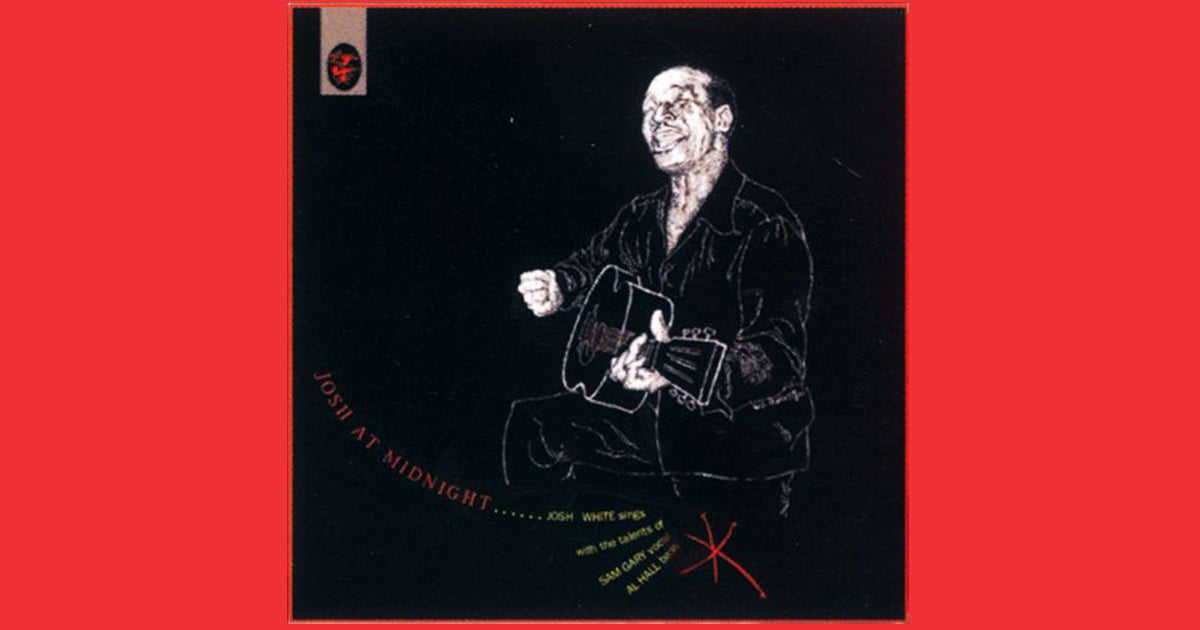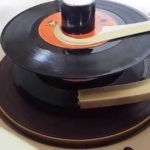It’s the time of year for saving money!
Preparation for this review of a new reissue from Ramseur Records took quite a bit more effort than I anticipated. I mean, at first the label sent me an advance CD which reminded me about the record and that I owned it.
Well… I thought I did…
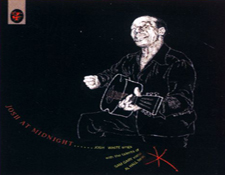 When I went to look for the LP to compare it to the CD, lo and behold it wasn’t in my collection. It must have been one of the 3,000 albums I purged when I downsized several years ago moving back into the City. Not entirely surprised, I probably figured at the time that it was an album I could pick up easily enough if I needed to. I mean, Josh At Midnight by Josh White was a very common sighting at record stores, thrift shops and garage sales most of my collecting life. It had been a mega seller back in the day which helped to establish Elektra Records as an important entity for the future as well as reviving the artist’s long career.
When I went to look for the LP to compare it to the CD, lo and behold it wasn’t in my collection. It must have been one of the 3,000 albums I purged when I downsized several years ago moving back into the City. Not entirely surprised, I probably figured at the time that it was an album I could pick up easily enough if I needed to. I mean, Josh At Midnight by Josh White was a very common sighting at record stores, thrift shops and garage sales most of my collecting life. It had been a mega seller back in the day which helped to establish Elektra Records as an important entity for the future as well as reviving the artist’s long career.
So I first went to Amoeba Records looking for a copy. No luck there. I then checked a bevy of thrift shops before and after my recent trip to the East Coast and had no luck. While back in Connecticut, I checked a slew of record stores, thrift shops, flea markets and junk shops to no avail.
Finally, today, the day I started writing this review a month or more later, I found a nice clean copy at Groove Merchant Records in San Francisco.
Whew!!
What happened to all of those copies I used to see everywhere???
Perhaps they have been destroyed? Gone to the great rummage sale in the sky? I don’t know. But its a good thing that Ramseur Records saw fit to reissue this early folk gem which was created by Elektra Records founder Jac Holzman himself, recorded at an old church with one microphone in New York City.
Now you are probably wondering why a publication like Audiophilereview would be interested in an simplistic old Monaural record like this — it is precisely because of this simplicity that you may want to check out this album. There is a lovely sense of soundstage here as you hear Josh singing and playing guitar along with bassist Al Hall and second vocalist Sam Gary.
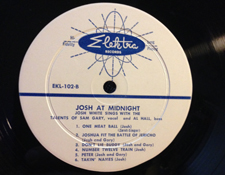 This production — as with most early pre-multi-track productions — was all about finding the right position for the performers and the mics in order to get a great sounding recording. After that, it was simply a matter of rolling the tape and capturing a good performance.
This production — as with most early pre-multi-track productions — was all about finding the right position for the performers and the mics in order to get a great sounding recording. After that, it was simply a matter of rolling the tape and capturing a good performance.
For this album, the mic of choice was a Telefunken U-47, for those of you who groove on that sort of detail.
And they did capture a bunch of songs which, frankly, I heard as a little kid in later incarnations by folk “revivalist” (if you will) stars such Peter Paul & Mary. The latter, for example ten years later, took album closer “Takin’ Names” and revamped it into a driving folk-rock piece called “King of Names.” “Well Well Well” on that same album borrows its chorus hook from “Jesus Gonna Make Up My Dyin’ Bed.”
Influence…
I don’t have room to write a lot of background about Josh but I can easily direct you to the Wiki which offers much detail on the artist’s influential history: https://en.wikipedia.org/wiki/Josh_White
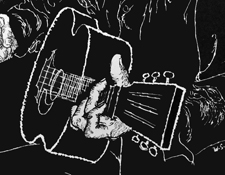 This is, however, probably a good time for me to bring up a perhaps touchy subject, but I feel it is an important one to point out for those of you young ‘uns who have a preconceived notion of what blues and folk music is “supposed” to sound like. Don’t get me wrong, I love the pretty harmonies of Fleet Foxes and their inspirations like Crosby Stills and Nash. I also love the raw brusk of Bob Dylan and the country-folk twang of early James Taylor.
This is, however, probably a good time for me to bring up a perhaps touchy subject, but I feel it is an important one to point out for those of you young ‘uns who have a preconceived notion of what blues and folk music is “supposed” to sound like. Don’t get me wrong, I love the pretty harmonies of Fleet Foxes and their inspirations like Crosby Stills and Nash. I also love the raw brusk of Bob Dylan and the country-folk twang of early James Taylor.
But… none of those artists quite represent the sound of many of the earlier wave of folk artists that I have heard. Sure, Woody Guthrie had a raw voice that influenced Dylan and many others. But when you listen to folk pioneers like The Weavers (ie. Pete Seeger, Ronnie Gilbert, etc.) or Burl Ives (yes, Burl! Go listen to his 1940s recordings for Moses Asch and for Columbia Records, both called The Wayfaring Stranger), you hear more singer-ly singers — if you will, for lack of a better term — singing this simple but passionate music.
So don’t expect Josh White to sound like Leonard Cohen or Neil Young or Joni Mitchell, but is no less folky. Josh White’s voice is not like Howlin’ Wolf or Muddy Waters, but is no less bluesy or passionate. His singular voice was arguably richer than Peter, Paul or Mary (three amazing singers who were collectively a powerhouse).
If anything, perhaps he’s more like a male version of Joan Baez, but even that analogy doesn’t quite do Mr. White justice. There are times when he sounds downright operatic!
]]>And there in lies the interesting rub to this story: hearing this big, obviously very well trained voice singing these old nuggets for the ages backed by nothing but his guitar and a bass can be pretty startling when you first get into it. Josh White’s clear-as-a-bell, rich and structured voice takes ownership of these songs. Some how works.
 He was a fabulous guitarist too! If you like Jorma Kaukonen and his post-Jefferson Airplane band Hot Tuna, you’ll probably dig Josh White’s finger-plucking and maybe even notice some influence there.
He was a fabulous guitarist too! If you like Jorma Kaukonen and his post-Jefferson Airplane band Hot Tuna, you’ll probably dig Josh White’s finger-plucking and maybe even notice some influence there.
Anyhow, the 180-gram pressing on this new Ramseur Records reissue was made at RTI on basic quiet black vinyl. It was mastered with the help of original producer Holzman working with legendary engineer Bruce Botnick. Mastering was handled by Bernie Grundman.
‘Nuff said…
This was clearly a handle-with-care release and the proof is in the pudding as they say. Mine played very quietly and sounded virtually identical to the original 1956 pressing, which is a good thing. It sounded better in some regards since inevitably there was some distortion on my old pressing, even though it is in fairly pristine condition. And I say this after playing the original with a Denon DL-102 Mono cartridge on my secondary turntable as well as via the Goldring 2400 on my primary stereo player, a MMF 7.1 by Music Hall.
The only real differences between the new issue and the original are cosmetic, particularly in the cover art, and there are arguments for owning each depending on how much you get into this record. First off, in preparing this review I learned that apparently the earliest original pressings had a 16-page booklet with it. Who knew? I didn’t get that in my copy of the original, so I didn’t miss it in the reissue, but apparently it was a thing (people are selling copies with the booklet up on eBay).
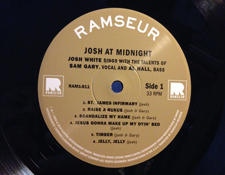 The cover art on the new one is really high quality with excellent semi-gloss graphics, printed on thick oaktag type cardboard cover stock; the original pressings were on a different sort of cardboard and the cover art was very shiny. The back cover features insightful new — and different than the original — liner notes by album producer and Elektra Records label founder Jac Holzman. The labels designs are also very different.
The cover art on the new one is really high quality with excellent semi-gloss graphics, printed on thick oaktag type cardboard cover stock; the original pressings were on a different sort of cardboard and the cover art was very shiny. The back cover features insightful new — and different than the original — liner notes by album producer and Elektra Records label founder Jac Holzman. The labels designs are also very different.
Again, all minor differences, no doubt, but important to some collectors, so I had to include that detail here.
All that said, this is real nice reissue. And for those rediscovering vintage folk and blues music, it is a good starting point as well as a great history lesson. For those audiophiles who might want something different to demo your system with, Josh at Midnight is as pure and simple a recording as one might want to demonstrate the a recording’s ability to capture the room sound even with a single great microphone. It is a very dynamic recording with rich lows from the acoustic stand up bass, sparkling mids and highs from the Josh’s guitar and that huge round voice which could rattle rafters as well as send a shiver down your spine.
This is the real deal…
